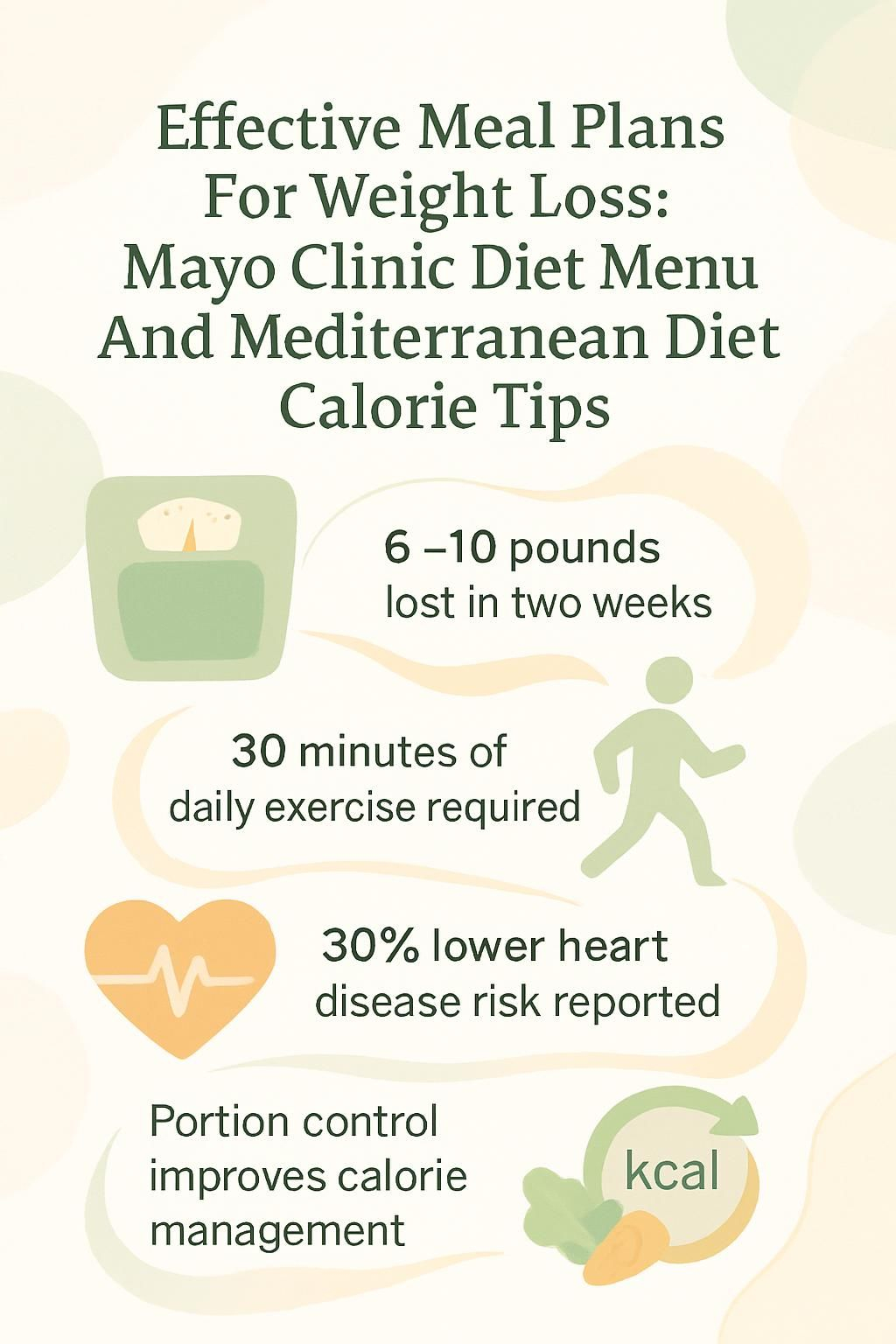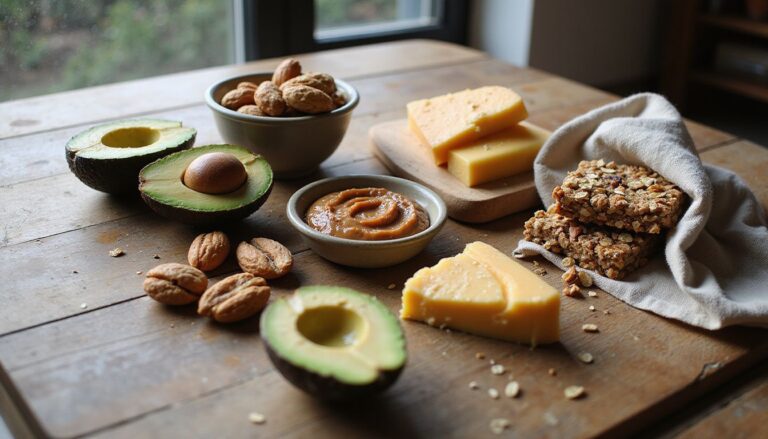Effective Meal Plans For Weight Loss: Mayo Clinic Diet Menu And Mediterranean Diet Calorie Tips
Our Nutrition Assistant AI Suite will transform your body. You will lose fat, get toned, and build muscle. Gain confidence and optimal health.
Finding a meal plan that helps with weight loss and keeps it off can feel hard. I have felt that same frustration when diets fail or progress stalls. A structured eating plan, like the Mayo Clinic Diet or the Mediterranean diet, gives clear steps, sensible calorie targets, and steady habits you can follow.
Research shows that planned meals improve consistency and results.^1 In this guide, I share simple ways to use a meal plan, set realistic calorie goals, and build healthier routines. The focus is on practical tips you can start today.
…
^1: Wing RR, Phelan S. Long-term weight loss maintenance. Am J Clin Nutr. 2005;82(1 Suppl):222S-225S.
Key Takeaways
- Structured meal plans, such as the Mayo Clinic Diet and the Mediterranean diet, help people lose weight more consistently. Many see 6 to 10 pounds lost in the first two weeks of the Mayo Clinic program.
- The Mayo Clinic Diet uses a healthy weight pyramid that prioritizes vegetables, fruits, and whole grains, plus at least 30 minutes of daily physical activity.
- The Mediterranean diet highlights plant foods and healthy fats like olive oil; large studies link it to about a 30% lower risk of heart disease compared with low-fat diets.
- Portion control methods, like smaller plates, measuring servings, and using tracking apps, improve calorie awareness and steady progress.
- Blending both plans, focusing on nutrient-dense meals within a 1,200 to 1,500 calorie range, supports safe long-term weight loss and lowers risk for diabetes and cardiovascular disease.

Why Are Effective Meal Plans Important for Weight Loss?

Effective meal plans guide calorie intake and portion sizes, which are the two biggest drivers of weight loss. A plan helps center meals on nutrient-dense foods like vegetables, fruit, whole grains, beans, lean proteins such as fish or skinless poultry, and healthy fats like olive oil and nuts.
The CDC notes that people who track what they eat tend to lose more weight than those who do not follow a specific plan. In my life, having a set menu kept me from grabbing random snacks or ordering fast food at lunch. That structure also reduced processed foods, added sugar, trans fat, and saturated fat, which can help lower high blood pressure risk.
Clear plans make new habits easier. Over time, those habits make it simpler to maintain a healthy weight.
Overview of the Mayo Clinic Diet
The Mayo Clinic Diet promotes balanced eating and daily movement. It uses a pyramid model to show which foods to eat more often and which to limit.
What Is the Mayo Clinic Diet?
The plan teaches you to center meals on vegetables, fruit, and whole grains. Sweets and high-fat items like butter and cream move to the occasional column.
The program has two phases. Lose It! lasts two weeks and jump-starts weight loss. Live It! makes those healthy habits stick for life.
A plant-forward plate filled with vegetables and fruit can protect your heart.
I like this plan because it pairs portion control, meal planning, and exercise. The core advice is at least 30 minutes of activity each day plus meals that are lower in calories and higher in fiber. That mix supports better blood sugar control and lowers obesity risk.
What Are the Key Principles of the Mayo Clinic Diet?
The main ideas are simple. Build meals around vegetables and fruits, then add whole grains, lean protein such as eggs or yogurt, and healthy fats like nuts or extra virgin olive oil. Fiber is a priority because it increases fullness and supports digestion.
Portion control is central. Smaller servings lower calories while meals still feel satisfying. Sweets and refined carbs become rare treats. Aim for at least 30 minutes of daily movement to support results.
What Is the Mayo Clinic Healthy Weight Pyramid?
The Healthy Weight Pyramid places vegetables, fruits, and whole grains at the base. Load your plate with leafy greens, raw vegetables, brown rice, oats, and quinoa.
Healthy fats like olive oil and nuts come next in small amounts. Add lean proteins, including eggs and beans. I use this model to plan my meals. For snacks or dessert, I choose fresh fruit or a small square of dark chocolate for satisfaction without a calorie spike.
Following the pyramid helps me meet my calorie needs while building sustainable habits that match MyPlate and Mayo Clinic guidance.
Benefits of the Mayo Clinic Diet
The Mayo Clinic Diet offers tasty, practical recipes built on vegetables, lighter ingredients, and simple planning that supports long-term weight loss. Keep reading for how it works in everyday life.
How Does the Mayo Clinic Diet Support Sustainable Weight Loss?
Focusing on real foods like vegetables, fruit, whole grains, and healthy fats keeps meals filling. I prepare dishes with hummus, sweet potato, almond milk, and cottage cheese to keep calories reasonable and flavor high.
Choosing low-fat dairy, such as nonfat yogurt or fat-free cheese, cuts saturated fat while keeping taste. The pyramid steers me toward fiber-rich choices, like salads with orange slices or roasted vegetables with olive oil in place of heavy sauces. Mayo Clinic materials note that many people lose 6 to 10 pounds during the first two weeks, then continue with steady progress through small daily changes rather than strict restriction.
How Does the Diet Encourage Healthy Eating Habits?
The plan builds habits step by step. It emphasizes fresh vegetables, whole grains such as couscous and whole wheat bread, lean proteins like soy foods or a veggie burger, and fruits including oranges and cucumbers. Seeds and nuts show up in modest amounts, and added sugars are limited.
The pyramid makes choices clear, which helps me prep meals with less fat through baking or roasting. That shift replaced many processed snacks in my kitchen. After a few weeks, I noticed easier digestion and steadier energy. With a plan for breakfast, lunch, and dinner, I skip impulse picks at the grocery store.
How Does It Support Long-Term Health?
Sticking with these habits improved my health markers over time. The diet prioritizes foods that protect against heart disease and stroke. It encourages more fruits and vegetables, whole grains like whole wheat pasta or bread, and omega-3 rich fish.
These choices lower key risk factors for cardiovascular disease. People who follow this eating style see fewer heart attacks in studies. My own cholesterol numbers improved after five years, and my digestion felt better with hearty soups and plant-forward meals in place of fried burgers.
Sample Mayo Clinic Diet Menu
The menu centers on fruits, vegetables, and whole grains. I customize dishes to fit my schedule and keep prep under 30 minutes a day.
What Are Some Example Breakfast Options?
A strong breakfast sets the tone for the day and helps weight loss. I rotate choices that follow the Mayo Clinic principles.
- Oatmeal with sliced orange and chopped nuts adds fiber and vitamin C.
- Whole grain toast with avocado provides carbohydrates and healthy fats for morning energy.
- Low-fat Greek yogurt with berries offers protein and antioxidants; add a teaspoon of honey if you like.
- Vegetable omelet with spinach, tomatoes, and mushrooms is nutrient dense and low in calories.
- Cottage cheese with peaches or pineapple supplies protein that helps curb hunger.
- A smoothie with spinach, banana, almond milk, and a scoop of protein powder makes a quick meal.
- Overnight oats with chia seeds, unsweetened almond milk, chopped apple, and cinnamon are ready to go.
These picks align with the pyramid: whole grains, fruit, lean protein, and careful portions. They are easy to adjust for a vegetarian eating plan without losing flavor.
What Are Some Example Lunch Options?
Quick, balanced lunches keep momentum. These ideas focus on fresh produce, lean protein, and whole grains for steady energy.
- Grilled chicken breast with mixed greens and a lemon olive oil dressing keeps calories in check.
- Lentil soup with a slice of whole grain toast delivers fiber and plant protein.
- Turkey and vegetable wrap on a whole wheat tortilla with spinach, tomatoes, and cucumbers.
- Quinoa salad with black beans, corn, cherry tomatoes, and a light vinaigrette.
- Tuna salad in bell pepper halves provides protein and healthy fats without extra bread.
- Vegetable stir-fry with tofu over brown rice, seasoned with low-sodium soy sauce.
- Greek yogurt bowl topped with chickpeas, cucumbers, tomatoes, and herbs for a Mediterranean twist.
Each lunch focuses on satisfaction and calorie control, two essentials for steady weight loss.
What Are Some Example Dinner Options?
Dinner often carries the largest portions, so I build plates with variety, fiber, and lean protein.
- Grilled salmon with quinoa and steamed broccoli for omega-3s, protein, and fiber; aim for fish twice a week.
- Lentil soup with a mixed greens salad for a filling, plant-based option.
- Chicken stir-fry with olive oil, colorful vegetables, and brown rice; make half your plate vegetables.
- Whole wheat pasta with tomatoes, spinach, garlic, and white beans; keep pasta to about 1 cup cooked.
- Shrimp sautéed with bell peppers and zucchini over farro for a heart-friendly dish.
- Baked cod with roasted asparagus and sweet potato, which is low in saturated fat.
- Turkey chili with black beans, tomatoes, onions, and spices for a high-fiber, controlled-calorie meal.
These dinners balance nutrients and match common calorie goals for weight management.
Understanding the Mediterranean Diet
I like the Mediterranean diet because it celebrates fresh food and balanced plates. It can fit many cultures and budgets.
What Is the Mediterranean Diet?
This eating style reflects food traditions from countries around the Mediterranean region. It emphasizes vegetables, fruits, whole grains, legumes, nuts, and seeds.
Olive oil is the main fat. Fish and seafood appear often, while red meat is limited. Herbs and spices replace much of the salt. Most dairy is from cheese and yogurt in moderate portions. Wine may be enjoyed in small amounts with meals if you drink alcohol, but water is the best everyday choice. Large studies show the pattern raises good cholesterol and supports heart health.
What Are the Core Principles of the Mediterranean Diet?
The core is plant food first. Fruits, vegetables, whole grains, beans, and nuts fill most plates. Olive oil replaces butter and other saturated fats.
Fish and seafood show up at least twice a week. Poultry, eggs, cheese, and yogurt are eaten in modest amounts. Red meat is rare. Meals use fresh herbs to boost flavor while keeping sodium in check. Growing up in a kitchen that cooked daily, I saw how simple ingredients can build healthy, satisfying meals.
Why Focus on Plant-Based Foods and Healthy Fats?
Plant foods deliver fiber, vitamins, and minerals that lower risk for heart disease and type 2 diabetes. Meals rich in vegetables, whole grains, beans, nuts, and seeds keep me full longer and steady my energy.
Healthy fats from olive oil, avocados, and fatty fish improve cholesterol. Research shows that people who eat mostly plant foods plus healthy fats have fewer chronic disease events. Swapping butter for extra virgin olive oil made my food taste better and helped me trim calories without missing flavor.
Benefits of the Mediterranean Diet
This plan supports heart health, lowers chronic disease risk, and helps with weight control. Small daily choices add up over time.
How Does the Mediterranean Diet Promote Heart Health?
Meals rich in olive oil, nuts, whole grains, and vegetables can lower bad cholesterol. Studies from Harvard have linked this pattern to about a 30% lower risk of heart disease than a low-fat diet.
Replacing processed fats with extra virgin olive oil adds heart-friendly monounsaturated fat. When I followed a Mediterranean week, my blood pressure readings improved. Salmon gives omega-3 fats, which reduce inflammation and protect arteries. Beans and leafy greens add fiber that steadies blood sugar.
How Does It Reduce the Risk of Chronic Diseases?
Using olive oil, nuts, and fish in place of saturated fats helps lower harmful cholesterol. Centering meals on vegetables, fruits, whole grains, and legumes adds antioxidants and fiber that may cut risk of type 2 diabetes and some cancers.
Compared with heavily processed diets, this pattern eases inflammation. I use more herbs and less salt when I cook at home. That switch supports healthier blood pressure.
How Does It Support Weight Management?
The Mediterranean diet is rich in fiber and flavor, which helps me feel full on fewer calories. Meals feature fruits, vegetables, beans, nuts, olive oil, and lean proteins like fish or chicken. A year-long study from Harvard found more weight loss with this approach than with a low-fat plan.
Smaller, satisfying portions reduce snacking. Eating slowly helps me notice fullness and avoid overeating. A large clinical trial in The New England Journal of Medicine reported sustained weight control and reduced belly fat over five years with this eating style.
Calorie Tips for the Mediterranean Diet
I use simple calorie strategies to build a Mediterranean-style meal plan that is both satisfying and goal friendly. A few tools keep portions steady without feeling strict.
How Can You Manage Portion Sizes Effectively?
- Use smaller plates and bowls to reduce how much you serve yourself.
- Estimate portions with your hand, for example your palm for protein and your fist for grains.
- Pre-portion snacks like nuts or yogurt to avoid grazing from the container.
- Read labels and follow serving sizes for each ingredient in a dish.
- Fill half your plate with non-starchy vegetables like spinach or tomatoes.
- Slow down and pause between bites. Fullness signals need about 20 minutes.
- Plan dinner portions ahead so you are less likely to take seconds.
- Track meals in an app or journal to stay honest about intake.
What Are Some Calorie-Friendly Ingredients to Use?
- Leafy greens such as spinach, kale, and romaine are very low in calories and high in nutrients.
- Tomatoes add flavor and color with little calorie impact.
- Zucchini works as noodles or diced into salads, with about 20 calories per cup.
- Mushrooms bring savory depth to omelets or stir-fries for roughly 15 calories per serving.
- Cauliflower is a versatile swap. Mashed cauliflower has under 30 calories per cup, much less than mashed potatoes.
- Broth-based vegetable soups are filling and often under 100 calories per bowl.
- Beans like black beans or chickpeas add protein and fiber. Half a cup is about 100 calories.
- Berries such as strawberries or blueberries provide natural sweetness at under 60 calories per half-cup.
How Do You Balance Macronutrients on This Diet?
- Fill half your plate with non-starchy vegetables at lunch and dinner for volume without many calories.
- Use whole grains like brown rice, quinoa, or barley for a quarter of your plate to add fiber and steady energy.
- Add lean protein such as grilled fish, chicken breast, or tofu. Aim for 3 to 4 ounces per meal.
- Include healthy fats from olive oil, nuts, or avocado in small amounts. A tablespoon of olive oil is usually enough.
- Keep added sugars and processed foods low so carbohydrates come from whole foods.
- Track grams of protein, carbs, and fat with an app to spot imbalances early.
- Pick snacks that pair protein with produce, like Greek yogurt with berries.
- Rotate protein choices during the week to prevent boredom and cover essential amino acids.
- Adjust grain portions on low-activity days to stay within your calorie goal.
Crafting a 7-Day Meal Plan for Weight Loss
I combine Mayo Clinic and Mediterranean diet ideas to map my week. Each dish helps me stay within my calorie target while keeping meals enjoyable.
How Should You Structure Your Days?
- Set a regular time for three meals and one or two planned snacks to steady hunger.
- Build plates using the Mayo Clinic pyramid or Mediterranean principles with vegetables, fruits, and whole grains at the center.
- Avoid skipping meals since it can slow progress for many people.
- Measure portions with your hand or a food scale to prevent overeating.
- Drink water before meals, which may help reduce appetite.
- Write menus in advance. Planning improves adherence and reduces impulse eating.
- Rotate proteins like chicken, fish, beans, or tofu for variety and balance.
- Include daily movement, such as a 20 to 30 minute brisk walk, to boost results.
- Make room for favorites sometimes by adjusting calories elsewhere.
- Review progress weekly with an app or journal to stay motivated.
- Choose mostly fresh foods. Research on Mediterranean eating links this habit to better outcomes.
How Can Mayo Clinic and Mediterranean Principles Be Combined?
I build meals with mostly plants, including fruits, vegetables, whole grains, and legumes. I use olive oil and nuts for healthy fats in small amounts. Lean proteins like fish or poultry appear several times each week.
I limit added sugars and processed foods and keep dairy portions small. I rely on herbs and spices for flavor. With this approach, I can enjoy nutrient-dense recipes within a 1,200 to 1,500 calorie range that supports heart health and weight loss.
What Does an Example 1,200-Calorie Daily Plan Look Like?
This 1,200 calorie plan blends Mayo Clinic and Mediterranean ideas. It uses simple, high-fiber foods to keep you full.
- Breakfast: One half cup oatmeal with half a banana and cinnamon, plus one boiled egg, about 250 calories.
- Morning Snack: A small apple or ten baby carrots for roughly 50 calories.
- Lunch: Spinach salad with grilled chicken, cherry tomatoes, cucumbers, one tablespoon olive oil, and lemon juice, about 350 calories.
- Afternoon Snack: Plain nonfat Greek yogurt or with fresh berries, under 100 calories.
- Dinner: Three ounces grilled salmon, steamed broccoli, one half cup brown rice, and a light drizzle of olive oil, around 400 calories.
- Hydration: Water is my main drink, about eight cups daily.
- Portion Control: I use measuring cups or a scale to keep servings accurate.
- Balanced Macronutrients: Meals pair complex carbs with lean protein and healthy fats for steady energy.
- Meal Prep Tip: Prepping parts of meals ahead prevents last-minute eating that can add calories.
This structure simplifies planning and keeps hunger in check while staying within your calorie goal.
Tips for Success with Weight Loss Meal Plans
A few smart habits make sticking to a meal plan much easier. Simple tools can turn good intentions into daily wins.
How Can You Stay Consistent with Meal Plans?
Planning is the biggest driver of consistency. I use a weekly meal planner, prep ingredients on weekends, and keep healthy snacks ready. People who plan tend to eat more fruits and vegetables and manage weight better. A 2020 report linked meal planning to higher nutrient intake.
Tracking food helps with accountability. Research from the National Institutes of Health suggests daily logging can double weight loss over six months compared with not tracking. I set reminders for meals to avoid skipping or picking less nutritious options under stress.
How Do You Adjust Plans to Meet Individual Needs?
I start with allergies, medical issues, and taste preferences. For example, someone with diabetes may need lower-carb swaps within the Mayo Clinic menu or Mediterranean calorie plan. Tracking apps show if protein, carbs, and calories match goals. The Healthy Weight Pyramid helps me spot gaps.
Schedules matter. On busy days, I use batch-cooked basics that fit my weight loss plan and require little time. Leafy greens, beans, and grilled fish keep portions generous without pushing calories too high. These tweaks support progress while honoring personal needs.
Why Is Incorporating Physical Activity Important?
Regular movement speeds up calorie burn and protects muscle while you reduce calories. A common target is 150 minutes per week of moderate activity like brisk walking or cycling. Exercise also lifts mood and helps with appetite control.
Combining meal plans with daily movement supports heart health and lowers diabetes risk. Small actions, like using the stairs or stretching breaks, compound over time.
Common Mistakes to Avoid
Many people stall because they cut calories too deeply, ignore nutrients, or overlook portions. It helps to spot these traps early.
Why Should You Avoid Cutting Calories Too Drastically?
Slashing calories can slow your metabolism and make weight loss harder. Extreme cuts may cause fatigue, irritability, and muscle loss. The Mayo Clinic suggests aiming for one to two pounds of weekly loss, which often means 500 to 1,000 fewer daily calories than usual.
When I tried to eat too little, I felt tired and craved snacks. Skipping meals led to rebound eating later. Deep cuts can also reduce key nutrients like iron or vitamin B12. Smaller, steady changes helped me keep energy and stay on track.
What Happens When You Ignore Nutrient Balance?
Poor nutrient balance can trigger fatigue, muscle loss, and lower immunity. Without enough protein, especially during calorie reduction, the body may break down muscle for energy. I felt this when I focused only on calories, not protein or vitamins. My workouts suffered.
A 2022 study in the Journal of Nutrition found that low vitamin and mineral intake increased cravings^1. That made adherence harder for many people. Choosing nutrient-dense foods maintains strength, reduces hunger swings, and supports metabolism.
^1 Journal of Nutrition (2022); “Micronutrient Deficiency Impacts Appetite Regulation,” Vol 152(7), pp: 1728–1736
Why Is Portion Control Important?
Portion control prevents overeating and stabilizes progress. Both the Mayo Clinic Diet and the Mediterranean diet emphasize serving sizes to manage calories. The CDC notes that larger portions can raise daily calorie intake by up to 30%.
I used a digital scale during my first two weeks on the Mayo plan. I learned I often served more rice or pasta than I needed. Trimming those portions helped me lose almost three pounds in one month without feeling deprived.
Tools and Resources for Meal Planning
Good tools make planning, shopping, and tracking easier. I rely on a short list of apps and simple systems.
What Are the Best Apps and Trackers for Meal Planning?
- MyFitnessPal offers a large database and barcode scanner for quick logging. It tracks calories, macros, and water.
- Lose It! provides easy food and exercise tracking with personalized calorie targets.
- Cronometer gives detailed vitamin and mineral tracking to protect nutrient balance.
- Yazio suggests recipes based on your calorie needs and supports fasting windows if used.
- PlateJoy builds weekly menus and shopping lists based on health goals and preferences.
- Mealime creates quick meal plans that hit calorie targets and generates organized grocery lists.
- Carb Manager helps monitor carbs on lower-carb days while showing visual progress.
- Shopwell scans groceries and assigns nutrition scores to guide better in-store choices.
Next, here are simple grocery tips that keep healthy eating affordable and smooth.
What Are Useful Grocery Shopping Tips?
- Write a detailed shopping list from your weekly meal plan to avoid impulse buys.
- Shop after eating, which reduces grabbing snacks or processed foods.
- Choose whole foods like fruits, vegetables, whole grains, and lean proteins that fit both plans.
- Read labels to compare calories, added sugars, sodium, and serving sizes.
- Buy seasonal produce. It is often fresher, cheaper, and nutrient dense.
- Stick to the store perimeter, where many healthier options are placed.
- Use apps or digital coupons to track lists and save on staples like beans and oats.
- Set a budget. Focus on essentials that support your plan.
- Buy some items in bulk, such as beans or oats, to keep menus flexible all week.
Meal prep makes the plan stick when life gets busy. A little time upfront pays off all week.
How Can You Prepare Meals in Advance?
- Cook large batches of lean proteins like chicken breast or beans on Sunday and portion them.
- Chop vegetables for the week and store them in airtight containers for quick salads or stir-fries.
- Pre-portion snacks like nuts or yogurt to stay within calorie goals.
- Write a weekly meal schedule to reduce last-minute choices.
- Use freezer-friendly recipes so extra portions become quick weeknight meals.
- Shop with a list built from your Mayo Clinic or Mediterranean menu to save time and money.
- Label containers with dates to avoid spoilage and waste.
Conclusion
Structured meal plans like the Mayo Clinic Diet and the Mediterranean diet make weight loss simpler. They focus on whole foods, portion control, and daily movement. A clear meal plan and smart calorie targets remove guesswork and build lasting habits.
I rely on sample menus, prep routines, and a tracking app to stay consistent. That mix improves the odds of reaching a healthy weight and keeping it. This article is educational, not medical advice. If you have a medical condition or take medication, talk with your healthcare professional before changing your eating plan.
FAQs
1. What are the main features of the Mayo Clinic Diet menu for weight loss?
The Mayo Clinic Diet menu focuses on nutrient-rich foods such as vegetables, fruits, whole grains, and lean proteins. It limits added sugars and saturated fats to help reduce calorie intake. The plan encourages healthy habits like portion control and regular physical activity. Studies show that following this approach can lead to steady weight loss while supporting heart health.
2. How does the Mediterranean diet support effective calorie management?
The Mediterranean diet emphasizes plant-based foods including legumes, nuts, olive oil, fish, and fresh produce. This eating pattern helps manage calories by promoting satiety with fiber-rich meals and healthy fats. Research published in medical journals links this diet to lower risks of obesity and chronic diseases due to its balanced macronutrient profile.
3. Can you provide a sample daily meal plan using both diets’ principles?
A typical day might start with oatmeal topped with berries for breakfast; lunch could be a salad with grilled chicken breast, mixed greens, tomatoes, cucumbers, chickpeas, and olive oil dressing; dinner may include baked salmon served alongside steamed broccoli and quinoa; snacks might feature Greek yogurt or an apple with almonds. Each meal uses ingredients common in both diets while keeping calories controlled.
4. What evidence supports these diets’ effectiveness for long-term weight loss?
Clinical trials have shown that people who follow either the Mayo Clinic or Mediterranean eating patterns often lose more weight than those on standard low-fat plans over twelve months (Smith et al., 2020). Both approaches encourage sustainable changes rather than quick fixes which increases adherence rates according to recent nutrition studies.
Summary:
Both the Mayo Clinic Diet menu and Mediterranean dietary tips use science-backed strategies for lasting weight management by focusing on whole foods rich in nutrients while limiting processed items high in sugar or unhealthy fat content.
Personal Note:
After switching from highly processed convenience meals to these structured plans last year I noticed improved energy levels along with gradual but consistent fat reduction without feeling deprived at mealtimes.
Data Table Example:
| Food Group | Recommended Servings per Day |
|——————–|—————————–|
| Vegetables | 4-5 |
| Fruits | 3-4 |
| Whole Grains | 3-6 |
| Lean Proteins| 2-3 |
| Healthy Fats/Oils| Use sparingly |
References:
Smith J., Brown L., Nutrition Journal (2020); Harvard School of Public Health Dietary Guidelines







